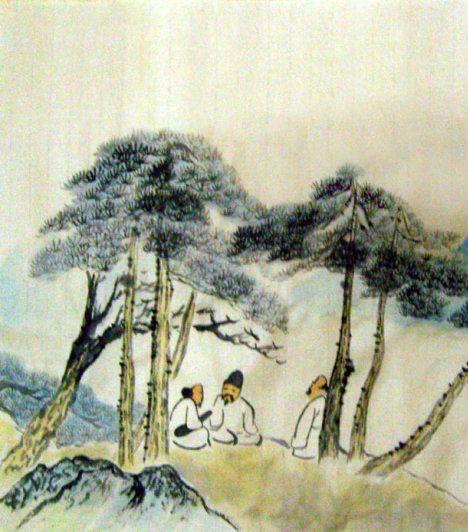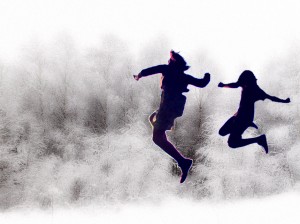5 kinds of meditation practises
At the SanCai school we practice 5 different forms of meditation i.e.
-
Anchoring meditation
-
Cultivating meditation
-
Choiceless awareness meditation
-
Inquiry meditation
-
Non-meditation (just sitting)
It does not really matter where you start. Not matter in the sense that a certain practice is not intrinsically better than another. However it greatly matters where you start in the sense that what you start with should be something that interests you, suites you or however you want to describe your relationship to a certain practice.
Our True nature is whole, nothing is missing. Hence describing meditation as stages of practice can be just as helpful as it can be misleading. That being said by not providing some description about it, we have little to talk about and then our approach becomes difficult to refine so talking about meditation in a way that leads to finer discernment and precision is something I have found to be very valuable both in my own practice and in teaching.
One such way is to reflect on our practise from four angels i.e.
-
The method or technique – what is it about, what is it axactly
-
States and stages – what happens in meditation as a result of practising
-
Fruits – The results in terms of insights and qualities such as wisdom, happiness, energy etc. i.e. outside of formal practise
-
The application of insights including mind, body, heart, soul, depth and expression i.e. how to live (embody) what we have understood.
The following is an example for how one might begin to learn the six forms of meditation. As I mentioned above this is something highly individual and should be guided primarily by the intelligence of ones intuition in conjunction with good advice from experienced friends or teachers.
1. Counting breaths (anchoring meditation)
We start with counting the breath from 1-10 over and over. Unless you have a strong feeling how you want to do it, starting with counting exhalations is a good way to begin. If the mind is churning obsessively and you loose track all the time then use the count on both inhalations and exhalations. On inhalation count 1 silently, on exhalation count 1 silently. On the next inhalation count 2 silently, on the next exhalation count 2 silently and so on).
When you loose count, just begin from 1 again on the next breath.
At some point in time (usually when some concentration ability has developed somewhat to the extent of being able to count for 5-10 minutes without getting lost) you can begin to be mindful about the things that distracts you. You find yourself being lost, perhaps in a fantasy. At this moment of awareness look at what is going on. What am I thinking, feeling, sensing (tactile sensations, seeing ,hearing, tasting, smelling)? Who is thinking, feeling, sensing? No need to do anything with what is going on, just take a moment to watch. Then you return again to counting.
2. Following the breath (anchoring meditation)
After some time with counting stop the counting and just be with your breath. Note that “some time” might mean a couple of weeks or years of practise but can even be in a single session.
3. The sensation of sitting (anchoring meditation)
After some time with being with your breath use the sensation of sitting as your anchor.
4. Loving kindness (cultivating meditation)
After some time with using the sensation of sitting as your anchor, do loving kindness meditation. In loving kindness meditation start with a thorough investigation of what loving kindness is. Contemplate loving kindness until you have a good, working understanding of it and then go into cultivating loving kindness.
5. Attention to the present moment (anchoring meditation)
After some time with loving kindness meditation sit with awareness of the present moment as your anchor. Start awareness of the present moment by asking yourself ”what is happening now?” and watch both what you primarily experience and your reactions to it (if any). After some time stop asking yourself and just pay attention.
6. Choiceless awareness
After practising awareness of the present moment turn to choiceless awareness. Just allowing to be be as they are without trying to do anything about it but curiously present to what ever is experienced.
7. Compassion (cultivating meditation)
After choiceless awareness turn to meditation on compassion. Maybe you have some supporting phrases that helps you to get into it, maybe just focusing on compassion directly is easier – whatever it is you find a way to make space for this quality to grow and sustain it with your awareness and intention. You might direct it to someone or something or just focus on the quality of compassion in itself.
8. Non-meditation
After meditation on compassion, turn to sitting without any object. You let go of any doing, any thinking, planning, meditating, trying etc. and just be.
9. Inquiry
After meditation on sympathetic joy turn to sitting with an existential question that speaks to you such as ”Who am I?”, ”What is the meaning of life?”, ”What is life?”.
10. Breath (anchoring and inquiry meditation)
Now go back to just following the breath for a while. Once you have reached a level of inner stillness and silence start inquiring into what is going on. What makes and in-breath start? What makes an out-breath start? What is the experience between the in-breath and the out-breath? What is the experience between the out-breath and the in-breath? What is the experience of the breath in different parts of the body (e.g. Nose, chest, back, stomach, heart, skin, etc.)? Can I be aware of my whole organism breathing? Who is breathing?
Now you have some practical experience of the 5 forms of meditation (anchor, cultivation, choiceless awareness, inquiry and objectless) and some of the combinations.
These 5 forms of mediation are practised in all four positions i.e. in sitting, laying, walking and standing.
There are many, many more ways of combining. After many years of practising these different methods will become different aspects of one thing – meditation. At this point you have transcended the notion of technique or method but there is a lot more to it than that!
Meditative absorption
Discerning the levels of absorption (dhyana) and insight can be through the use of any of these 5 forms of meditation. It is quite possible to experience all levels of absorption using just one of the 5 methods described above so again – it is perfectly OK to just stick with one of them that suites you and dive deeper into that.
The practice of absorption is called Shamatha in Sanskrit (Zhi in Chinese) and the practice of insight is called Vipashyana in Sanskrit (Guan in Chinese). My experience have led me to believe it is good for ones own understanding to discern the two but not to separate them but rather look at them as two sides of the same coin. There are some fundamental problems with this approach of looking honestly and reflecting on what is going on in my meditations and what this leads to however. The main one is that the attainment of a certain result e.g. a state of absorption, easily fuels the notion of someone attaining it i.e. it reinforces the self image with things like pride and of separation or of being special. That being said, I believe the benefits outnumbers the problems, especially if those kind of results are also looked at honestly and curiously. I have some chocking experiences of talking with Zen practitioners who have been sitting regularly for more than 2 decades doing retreats regularly but have very little understanding about themselves or of deeper levels of meditation, rather they seem to have gotten stuck in some kind of passive vegetation believing they did true Shikantaza.
Being able to enter the various states of absorption does not in itself mean a guarantee of any fundamental break-through. It does provide access to different levels of consciousness, one could even say access to different worlds, which is helpful in the inquiry as it provides different perspectives to do engage in inquiry from. It also bears with it some fruits that are very helpful in inquiry such as calm, clarity, sustained focus, energy, extra-ordinary sense perceptions etc. that both brings more power and depth to the inquiry and also balances some of the tendencies to become restless, agitated, overwhelmed etc. when doing inquiry.
When practising emphasizing the absorption aspects I have found it helpful for many (myself included) to do longer periods of meditation e.g. Sitting for 45 min to an hour each time.
When practising emphasizing insight I have found it helpful to shift more often between sitting and walking e.g. Sitting for 20-25 minutes, then do 5-10 minutes of walking, then sit (or stand or lay) again for 20-25 minutes and so on.
Cultivation of qualities
Another important angle on meditation is cultivation (Bhavana in Sanskrit) of qualities. Traditionally the qualities of loving kindness, compassion, sympathetic joy and equanimity are particularly stressed since they are so supportive to ones meditation practice. Another important set of qualities are the 7 enlightenment factors i.e. mindfulness, discernment, energy, rapture, peace, concentration, and balance and also the 6 perfections i.e. generosity, virtue, patience, diligence, awareness, and wisdom. I have found some others to be very important as well. They are openness, curiosity, love of truth, personal responsibility, creativity, commitment , freedom in relationship to experiences, and clarity. Cultivation has two sides to it. One is the level of contact with this quality within oneself and strength of the particular quality that is being cultivated. The other is acting from and out of this quality in ordinary life e.g. to be more lovingly kind to family, friends and strangers.
Are the insights that I have or the qualities I cultivate constrained to certain aspects of my being (e.g. intellectual and physical) or do they encompass me as a whole? When we sit in open curiosity, listening and wondering it is possible to find out!

